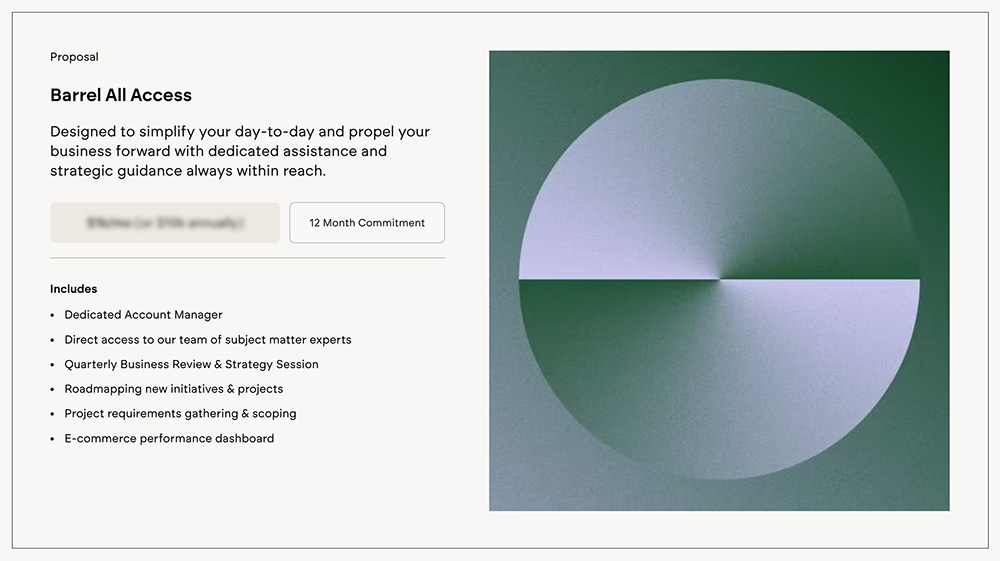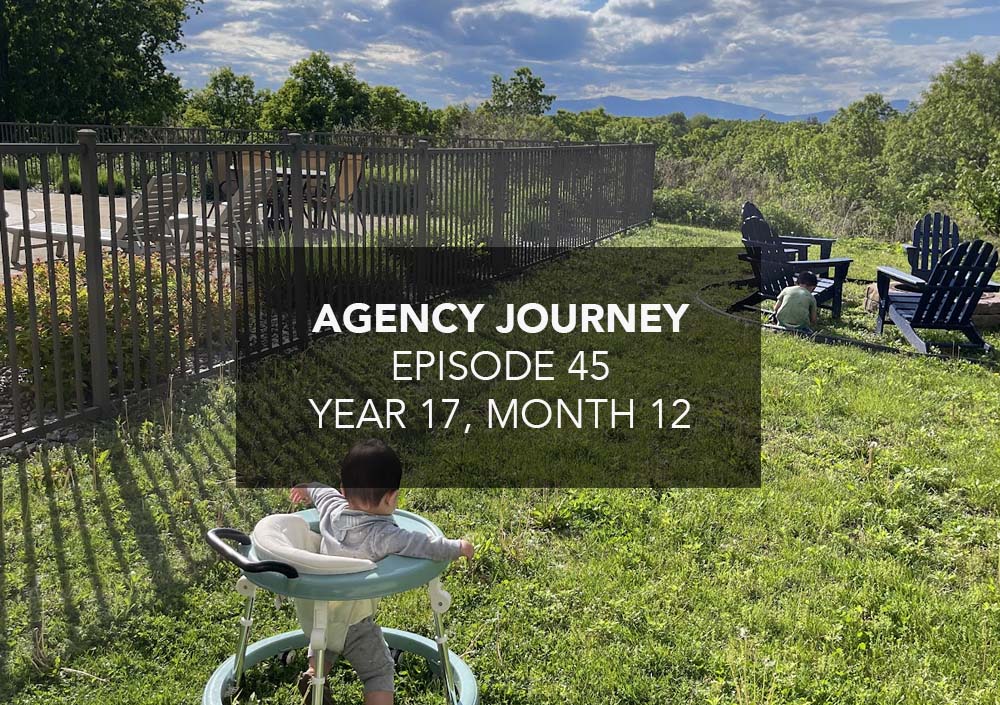Our family enjoyed a wonderful Memorial Day Weekend as we hosted some friends and spent quality time with kids in the pool, eating BBQ, and relaxing in perfect weather. Incredibly grateful for the wonderful time.
I still remember the holidays of my past, when I would feel burdened with thoughts of work, convincing myself I needed to devote some hours catching up on proposals and emails. I’d often work myself up to a certain level of anxiety the night before work, worried about all that could go wrong the upcoming week.
It’s not that business has gotten easier. In some ways, as you’ll read below, some things are harder. But I think I’ve gotten better at choosing how to feel about work, life, and my priorities. On a rare long holiday weekend, my family and friends get my attention. The challenges of what’s going on at work can wait. In fact, I know that if I do a good job of relaxing and enjoying my time off, I’ll be refreshed and in a stronger mindset to take on those challenges when I’m back.
Eighteen years of owning a business and being my own boss, this is a small yet very important realization – that I have more power over how I experience my life than I may have believed when I first started. Things rarely have to be crazy, stressful, and hectic, and it’s in my control to make it so.
About Agency Journey: This is a monthly series detailing the happenings at my agency Barrel, founded in 2006. You can find previous episodes here.
Highlights
Revenue Booking Struggles Continue
For the second year in a row, Q2 has been a very slow period for booking new revenue. We’ve been active in terms of pipeline activity as we continue to qualify a steady stream of new leads, create proposals, and have closing conversations. Unfortunately, as close as we are with some deals, not enough signings have materialized.
We’ve adopted the mindset of “hope for the best and plan for the worst”, gaming out all the scenarios for the upcoming weeks. All it takes is 3 to 4 of the late-stage deals to sign by a certain date, but we know from experience that there are no guarantees.
In times like these, we continue to tell ourselves: “Control what we can control, focus on the inputs.”
Shifting Away from Selling Hours
One of the things we can control is what we sell to our clients.
We’ve long defaulted to selling buckets of hours, giving clients the option to buy certain blocks and then draw down on them based on their requests or agreed-upon tasks and mini projects.
When executed well, the bucket-of-hours approach is fairly straightforward: we roadmap and prioritize tasks and mini projects with the client and then log against the block of hours, making a good margin on each hour while delivering on the agreed-upon tasks.
But the reality is, the bucket-of-hours approach has some pitfalls:
- When certain tasks eat up more hours than anticipated or the client feels we’ve not made enough progress within the allotted hours, they’re more likely to want to scrutinized how we used the hours.
- When we don’t roadmap proactively and have tasks planned and ready to go, the client may feel overburdened by having to come up with requests to use the hours, thereby leading them to question whether or not they need so many hours in the first place.
- Related to the previous point, when we default to being order-takers to the client, the client may sense that we’re not “strategic” enough and look to replace us with either A) a lower cost order-taking replacement resource and/or B) a more strategic and proactive firm that brings rigor to the engagement.
You can do well with a bucket-of-hours approach, but it boils down to execution. But perhaps a different engagement structure can also help us be more proactive by default.
Our Chief Experience Officer Lucas Ballasy has been experimenting with new engagement models. We’re taking hours out of the equation and instead selling clients on certain activities and outcomes.
Our Barrel All Access offering provides the base for this new hour-less concept. All Access is an annual retainer at a fairly low cost that provides clients with proactive account management, quarterly strategy sessions, requirements gathering & scoping, roadmapping, and analytics reviews.

Barrel All Access forms the foundation for us to provide tightly scoped fixed fee engagements to add new features, redesign the website, or improve site performance. We also have additional retainers that can layer on to provide quick turnaround ad hoc support or ongoing conversation rate optimization.
The reception and feedback from clients have been informative and encouraging. We’ve been continuing to make tweaks to the model and the language surrounding it to improve it for clarity and compatibility with different types of client situations.
As with any new service offering designs, time will tell whether or not it’s a drastic improvement over the bucket-of-hours approach, but this is definitely an experiment worth pursuing.
Top of Mind
The Road to Avoiding Commoditization
There are too many agencies who do great user experience design and front-end development on a platform like Shopify. In fact, there are countless freelancers who can do work better than most agencies as well. To compete on web design and theme customization is a losing game because too many people can do a great job and you can always find someone willing to do it for less.
You can argue that backend development, systems integrations, and custom app builds are also becoming commoditized by offshore dev shops and savvy freelancers along with an ever-growing library of ready-to-use code components and other resources that level the playing field.
So to be a growing Shopify web agency beyond 2024 means you need to offer something more compelling than good design and dev. Solving for this and being able to convince clients of the fact is the existential question, I think, for agencies that have long been focused mostly on the design and dev offering.
Assuming design and dev are table stakes, what are areas of expertise and services to meaningfully layer on and position differently?
Our efforts here are in progress, but here are some ideas and threads we’re exploring:
- Focused vertical/sector backed by specialized knowledge in these industries. For example, our experience with CPG food & beverage has helped us close such opportunities at a higher rate, and we’ve been working to sharpen our POV and to add to a growing library of best practices specific to such clients.
- Deeper customer research and insights that inform strategy. Being able to shift from design that “looks good” to creating user experiences that are backed by real customer behavior data and qualitative interviews could lead to more impactful initiatives.
- Analytics tracking, reporting, and insights. Being more hands on with measuring the impact of the agency’s work and developing a cadence to review progress with the client along with recommendations to test new hypotheses.
- Complementary services that are tightly executed together. SEO, email marketing, and paid marketing are all services that can leverage existing design and dev services while having greater influence on areas like customer acquisition and retention.
- Becoming the very best with very specific aspects of e-commerce websites. This can be a further niching down on the horizontal level (first level being Shopify) – perhaps the focus is on something like being the very best at implementing subscription services, loyalty programs, or even very Shopify-specific SEO or accessibility services.
- Cutting-edge innovation. Pushing clients to test out the latest technologies that their competitors have yet to try (e.g. AI, experiential, etc.) through thought leadership and careful curation of client types who are willing to bet on unproven technologies ahead of others.
We won’t be able to adopt or execute across all of these, but you can quickly see that beyond the design and development of Shopify websites, there’s a lot more we can be doing (and to some extent, we already are). This also begs the question: how will the team makeup evolve as we dive deeper into certain areas and expand our services? I can see us hiring people from industries where we’re looking to go deeper. I can also see us hiring more strategists, researchers, marketers, and other roles that are very different from the design and development resources we’ve largely focused on for much of our history.
Change is happening. It’s never easy experiencing increasing levels of competition and a feeling that our core offering is slowly beginning to lose relevance. But it’s a great reminder to keep talking with our clients and to proactively discover ways we can serve them better. A year from now, I expect to that Barrel will have undergone quite a transformation.
Shared with Partners
“I can tell you this, though: after a lifetime of swimming upstream, I am convinced that one of the real secrets to Wal-Mart’s phenomenal success has been that very tendency. Many of our best opportunities were created out of necessity. The things that we were forced to learn and do, because we started out underfinanced and undercapitalized in these remote, small communities, contributed mightily to the way we’ve grown as a company. Had we been capitalized, or had we been the offshoot of a large corporation the way I wanted to be, we might not ever have tried the Harrisons or the Rogers or the Springdales and all those other little towns we went into in the early days. It turned out that the first big lesson we learned was that there was much, much more business out there in small-town America than anybody, including me, had ever dreamed of.” (Sam Walton and John Huey, Sam Walton)
It’s stories like these (of Walmart) that inspires me when the going gets tough in business. I know that we’ll be forced to work within constraints and under certain pressures, which will then lead to innovation and creativity.
“Today I play every point to win. It’s simple and it’s good. I don’t worry about winning or losing the match, but whether or not I am making the maximum effort during every point because I realize that that is where the true value lies.” (W. Timothy Gallwey, The Inner Game of Tennis)
This is the mentality we tell ourselves to bring to every new qualified lead. We’re never sure we’ll win or lose, but we absolutely need to play to win, which means showing up enthusiastic and curious and following through with well-considered questions and proposals.
“For a firm to be truly innovative, it must not only do new things, it must stop doing old things. It is not possible to create tomorrow unless one first disposes of yesterday. Maintaining yesterday is always expensive. The human body has an automatic mechanism to discharge waste, but it appears the corporate body does not—that requires leadership and vision. Drucker was also fond of saying, ‘Results are achieved by exploiting opportunities, not solving problems. Solving problems only returns the company to the status quo’.” (Ron Baker, Implementing Value Based Pricing)
An apt quote given things on our mind lately. Avoiding the commoditization trap in our business means we’ll have to make tough decisions on stopping certain activities.
